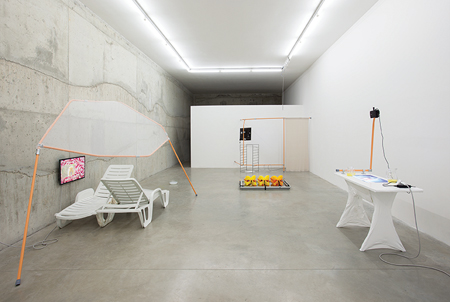Material Uncertainty

The video starts with R. Kelly’s voice singing, ‘My mind’s telling me no, but my body’s telling me yes’ – the opening line of his 1994 song ‘Bump n’ Grind’ – while the work’s title, The Uncertainty Seminars, is spelled out in pale pink, before fading away again, absorbed by a rosy background. A dog barks. The song stops. A ‘Table of Contents’ appears on a new, raspberry-pink background: Mission, Motivations, Principles, Visualization, Methods. A bell rings; the word ‘THINKING’ runs across the screen. A Siri-esque voice proclaims: ‘Art, the privileged place of experimentation for the precariousness of life, language and labour. We form amorphous clusters that make up an international network. Our work is pushed forward into the immensurability of value in relation to time.’ The subject is uncertain and only demarcated by age: ‘We are young creative and talented. We don’t know exactly what we’re going to do and how we’re going to make a living. Lack of security defines our lives.’
Could technology open a way to self-knowledge and peace of mind, instead of merely sedating our fears? New York-based Andrew Norman Wilson’s video The Uncertainty Seminars (2013–ongoing) – a work-in-progress – tries to answer the question by merging the language of corporate aesthetics and self-help seminars (PowerPoint presentations, candy colours, motivational slogans) with the ABC of post-digital aesthetics (the uncertain divide between mind and body, perception and reality, images and objects). And with a good deal of irony, thankfully.
Curated by Alex Ross and entitled ‘Material Uncertainty’, the show at Fluxia was staged over the two floors of the gallery: Olivia Erlanger (also from New York) showed in the basement while, on the ground floor, the five episodes of Wilson’s film played on flat screens housed in installations made in collaboration with the Chicago-based artist Nick Bastis. DIY or home store items such as white plastic garden furniture, orange metal railings and a mattress prompted viewers to lie down, lean against, climb over, look up and down, as in a yoga routine, complete with devices to hydrate and humidify: jugs placed on a shrink-wrapped table filled with bright orange SunnyD juice (Table of Contents, 2014) and a glass bowl on the floor filled with water, as if for a dog (yourdadsemailaddress, 2014). The makeshift appeal of these fittings, which recalls Franz West’s humorous approach, counterbalanced their minimalist coolness. Group Therapy (2014) consists of two sunbeds scruffily melded together at the armrests (such that two people lounging on them would be facing each other) placed under a lopsided canopy beneath which a hilarious episode of The Uncertainty Seminars played out on screen. Set in ‘La Borde Clinic, California’, it stars two chow dogs who claim to have started a schizo-analytic group courtesy of Giles Deleuze & Félix Guattari, in reaction to Freudian orthodoxy. We learn of Freud’s predilection for a chow that was companion of his last years, as well of the pet’s disgust for the old man’s cancer-ridden jawbone. A stock image of minced meat pops up in the corner of the video, where the picture curls like a the dog-eared page of a book to show what’s below: as in a medieval macabre painting, the exposure of flesh signifies the fragility of our material form.
In the room downstairs, all is black and white, deliberately alienating. Erlanger’s ‘Customizable I-VII’(2014), a series of CNC-routed aluminium panels (echoing the latest trend in laser-etched Macbook shells) line the walls, while the sculpture The Space Between My Hand and What It Holds (2014) recalls a miniature Zen garden, with porcelain casts of the artist’s hands as rocks and grains of so-called Gorilla Glass (the type used for the screens of mobile devices) as sand. Wilson writes: ‘I am interested in how the Serenity culture is marketed to ensure that the workforce keeps working and all anxieties are soothed, furthering the myth of technology as a tool for social agency and well being.’
This post-digital moment could be described, to use Walter Benjamin’s term, as the ‘just-past’; or, as Dan Graham put it in 1987, ‘that period in time made amnesiac by commodity culture’, infused with ‘a sense of eternal newness’ through objects, fashion and merchandise. So where does this eternal newness, courtesy of pacifying and distracting technological devices, actually lead us? ‘Material Uncertainty’ doesn’t pretend to know the answer, but it manages to embody the current zeitgeist so perfectly that it almost automatically flips into parody.
















